
News, Insights, and more on Industrial IoT
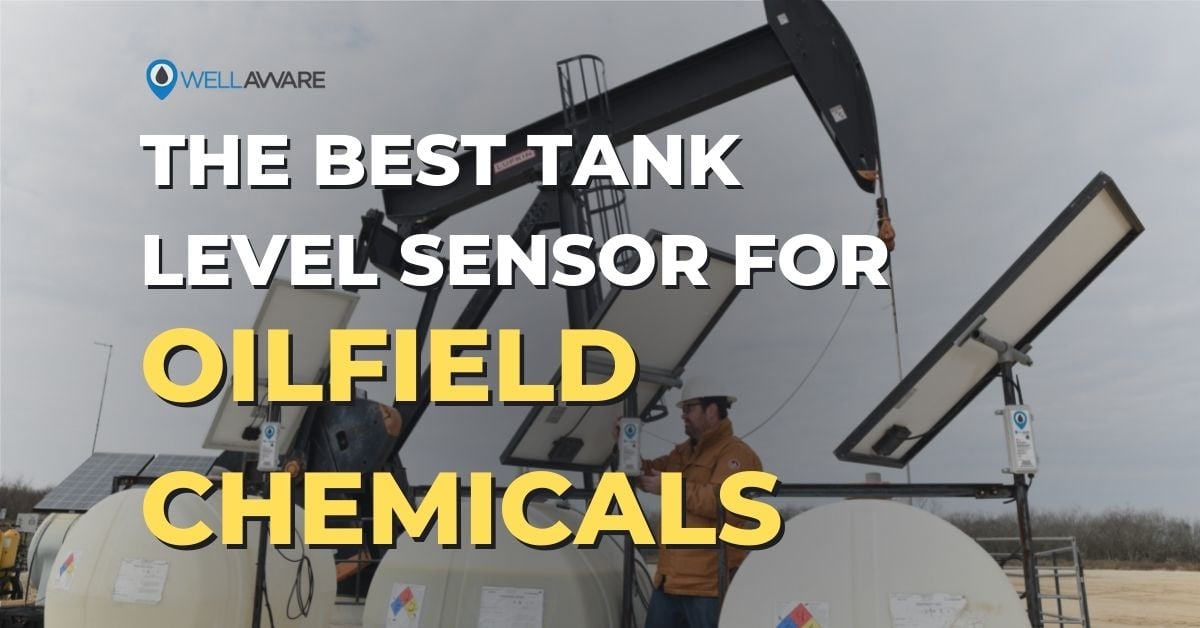 If your job involves managing oilfield specialty chemicals, no doubt you’ve considered implementing chemical tank level monitoring. Maybe you’ve even set up a few chemical tank level sensors here and there to try it out.
If your job involves managing oilfield specialty chemicals, no doubt you’ve considered implementing chemical tank level monitoring. Maybe you’ve even set up a few chemical tank level sensors here and there to try it out.
Whether you work for an oilfield chemical service provider, a producer, or a pipeline company, you probably have the same question about your chemical tank level sensor:
How long until this thing gives out?
Oilfield chemicals can be pretty nasty. Whether you’re dealing with amines or peracetic acid, these specialty chemicals can eat to bits even the most rugged sensors.
Listen, we’ve been down this road. We’ve been automating oilfield chemical injection systems for nearly a decade, and we’ve tried dozens of sensors from different manufacturers in that time.
We have a lot of experience selecting sensors that work well in the oilfield, and we’ve rigorously tested compatibility across all kinds of specialty chemicals, from combo inhibitors to methanol to sour gas scavengers.
Through our experience, we’ve learned the important factors to consider when selecting a chemical level sensor, and we’ve even landed on a particular sensor that stands above the rest in each of these factors. Read on to learn more.
These are the 5 critical factors that determine if a sensor will be a good fit for oilfield chemical applications:
FYI - if you're wondering what types of tank level sensors are out there, check out this blog.
Here’s the thing about any kind of tank level sensor: if you want more accuracy, you’re going to pay more. It really is that simple. The reality for oilfield chemical applications is that they tend to be pretty cost-sensitive (more on that later), so we have to ask ourselves: How accurate is accurate enough?
Consider that the alternative to automating chemical tank levels is manual inspection, which typically involves viewing perceived chemical levels through the translucent walls of the chemical tank, and matching it up to visible volumetric markings on the side of the tank.
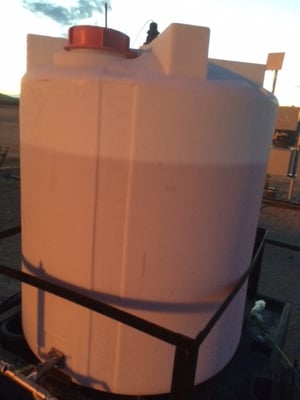
Low lighting can make manual tank readings even more challenging.
This process is, well... imprecise. It depends on environmental variables, weather, visibility, and on. Put simply, you’re likely to get a different reading from a different field hand on a different day, even if the level in the tank hasn’t changed a bit. In practice, most tank markings are displayed in 5-10 gallon increments, so we should expect a manual reading to be accurate to about 2-5 gallons.
Most tank level sensors, regardless of cost, can achieve these levels of accuracy - or better - if calibrated properly. So the decision really comes down to the next 4 factors…
In oilfield chemicals, material compatibility is key. Sensors that come into contact with chemicals need to be resistant to the chemistry, meaning their wetted materials should be tough stuff.
But compatibility goes beyond just material compatibility. Applicability is an important aspect of compatibility. Said in a different way, can the sensor effectively measure chemical levels in an oilfield environment? Some sensors will lack the necessary weather or hazardous area ratings. Others, like ultrasonic sensors, may not be compatible with chemicals that produce vapors or foams. Others may require too much power in environments where power budgets may already be skimpy.

Many chemical pumps run on solar power. Can your solar setup handle the additional load from a power-hungry sensor?
So when selecting a sensor for compatibility, consider the materials, yes. But also keep in mind whether the sensor can stand up to the unique challenges created by the oilfield.
Installing chemical tank level sensors can be challenging, to say the least, especially in brownfield applications where chemical tanks are already commissioned (this tends to be the majority of installations these days). Submersible sensors will need a port to access the tank interior. The level transmitter will require some sort of mounting position.
Sensors with predetermined lengths, like floats or capacitance sensors, might be off the table as well, since they have to be pre-fitted to a specific size of the tank. Floats can be an attractive option for their accuracy and repeatability, and in theory, floats can work if the tank sizes are well-documented prior to procurement.
In practice, however, this is a nightmare. Sensors often need to be relocated or reused on tanks of different sizes, so the flexibility of installation in brownfield applications is key.
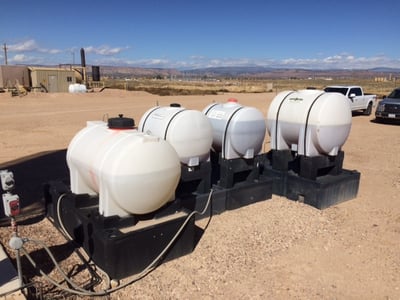
Oilfield chemical tanks come in all shapes and sizes, which can make sensor installation tricky.
Furthermore, some installation methods simply don’t work for oilfield chemical applications. For example, some vendors will try to install a hydrostatic sensor on the discharge line of the tank, before the pump suction. While this may seem like a great way to avoid submerging a sensor in the tank while getting the low-cost advantage of a hydrostatic, there’s a problem:
When the chemical pump runs, it creates a temporary suction pressure in that discharge line. Hydrostatic pressure sensors read the fluid level by measuring the pressure exerted by the weight of the chemicals. The pump suction effects introduce a tremendous amount of noise which can require complex filtering. For most applications, it’s simply a non-starter.

This chart shows how externally mounted tank level sensor signals, shown in blue, are affected by the chemical pump suction. Submersible sensors, shown in red, do not experience the same effect.
This is the oilfield, and we all have a goal of zero incidents. Our sensors need to align with our safety culture too.
At a minimum, this means that chemical tank level sensors need to carry hazardous area certifications specific to the environment in which they are deployed.
But it goes beyond just certifications and into specific practice. Here’s a quick story to make the point:
Many years ago, WellAware installed about a hundred chemical tank level sensors in the dry, dusty regions near Pecos, TX. This area is prone to thunderstorms coming off of the Davis Mountains, which create safety concerns in their own right but also impact sensitive instrumentation like tank level sensors.
The windy conditions in West Texas cause dust and sand to whip over chemical tanks. Because tanks often sit on a plastic containment, they aren’t properly grounded, meaning they have a tremendous potential to build up a static charge, especially during heightened electrical activity.
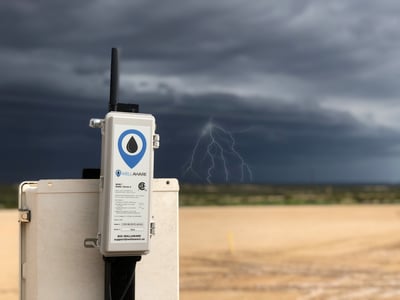
WellAware chemical tank level sensors come with grounding kits to prevent the dangerous discharge of static electricity.
WellAware discovered that our sensors were being destroyed by a sudden discharge of static electricity into the sensor due to a lack of grounding in the tanks. Fortunately, nobody was injured and no property was damaged, but we learned an important lesson. From that point forward, all of our tank level sensors have been installed with grounding kits to prevent unsafe static discharge.
You can consider any new technology without considering the cost. Everybody in the oilfield - from service providers to operators - is trying to run a lean chemical program. Fancy sensors with high-price tags simply aren’t acceptable. Here’s a great rule of thumb: If the sensor costs more than the tank it’s monitoring, it’s probably a no-go for oilfield chemicals. That means our sensors can't cost more than a couple hundred bucks.
Plus, no matter how reliable an oilfield chemical tank level sensor is, it’s going to fail eventually. Just like death and taxes, sensor failure is inevitable in the oilfield. In most cases, chemicals will make their way into the sensor housing through the cable gland and gobble up the electronics. If you’re constantly replacing high-dollar sensors every few years, that’s going to start to add up.
So what is the best oilfield chemical tank level sensor? While new technologies are constantly being developed, our experience has shown us that one particular sensor stands out: The custom-built Druck Unik5000 that WellAware uses in all of its chemical tank level monitors.
We’ve worked with the engineers over at Druck to refine this particular sensor to deliver great accuracy at a low cost, and with materials and certifications specifically suited to oilfield chemical applications.
The 316L stainless steel sensor body and diaphragm, coupled with the chemically inert Kynar cable, stands up to nearly every oilfield specialty chemical. The sensor comes with temperature compensation for those hot West Texas days and cool nights, plus reference pressure and ventilation measures to ensure that pressure build-up in the tanks doesn’t mess with your level readings.
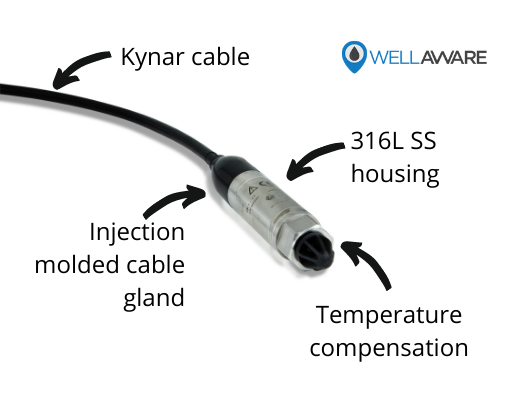
WellAware uses a custom-built Druck Unik5000 - the perfect combination of accuracy, reliability, and cost, for oilfield chemicals.
But the best part of the Druck Unik5000 is a design feature that makes it perfectly suited to oilfield chemical applications. Every WellAware Druck Unik5000 comes with an injection-molded Kynar cable gland that is virtually impervious to chemical fluid ingress. This is important since we replace failed sensors at no added cost to our customers.
With apologies to the Dodge and Chevy fans out there, the WellAware tank level sensor is like the Ford F-150 of chemical sensors. It’s cheap, reliable, and it’s not going anywhere anytime soon.
To learn more about our chemical automation solutions, visit https://wellaware.us/chemical.
Like what you're reading? Sign up for updates!
Have a Question?